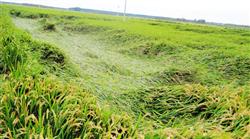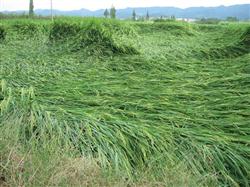Why does rice lodge? How to prevent and cure it?

Why does rice lodge? How to prevent and cure it? Please introduce that the earlier the rice lodging occurs, the greater the impact on the yield, the serious plots can reduce the yield by more than 50%, or even cause no harvest. Lodging also has a great impact on rice quality, but also increases the difficulty of harvest. Although rice lodging is related to windy and rainy weather, it is mainly caused by poor lodging resistance of rice. For example, the lodging resistance of varieties is weak, the population density is too high in the early growth stage, the basal internodes of rice are too long and the root system of rice is underdeveloped and so on. The causes of rice lodging are different, and the lodging forms are also different. In production, the causes of lodging can be found out according to the form of lodging, and then corresponding defense countermeasures can be taken. Rice lodging can be divided into three types: "stem bending", "stem folding" and "shallow root lodging". The stem bending and inverting subsequently increased with the grain filling panicle weight, and when the panicle weight exceeded the stem bearing capacity, it led to different degrees of bending and tilting of rice until it crept on the ground. The greater the degree of bending and inclination of the stem, the greater the adverse effect on rice. When the ear touches the ground, the degree of loss increases significantly. When rice entered the late stage of grain filling, the nutrients of leaf sheath and stem were transferred to grain, and the supporting capacity decreased, and lodging occurred more in the later stage of grain filling. This kind of lodging is mainly related to the excessive number of panicles per unit area, large panicles and excessive fertilization in the middle and later stages of growth. Stem collapse is the lodging type that causes the heaviest loss in production. Once the stem is broken, the base of the stem is broken, and the normal grain filling of the rice ear almost stops. The poor drainage condition of paddy field, poor soil ventilation, shallow soil plough layer, small root growth, weak stem development and weak stem elasticity are related to the poor drainage condition, poor soil ventilation, shallow plough layer, small root growth, weak and fragile stem elasticity. With the application of more nitrogen fertilizer in the early stage and deep water irrigation, the population density of paddy field was higher, especially when the basal Internode of stem was longer. The soil fixation ability of shallow root inverted rice root is poor, and the lodging formed by the tilt at the base of the stem is shallow root lodging. The light ones tilted the stalks and the heavy ones crept on the ground, which generally occurred earlier and the yield was reduced greatly. The roots of rice seedlings are too shallow in the soil, resulting in floating roots, and the ability to support rice plants is weak, which not only affects the normal growth of rice, but also prone to lodging. There are many floating roots in throwing seedling planting rice and direct seeding rice, and shallow roots are easy to fall. In the muddy field and saline-alkali paddy field with poor drainage, the shallow root of rice is easy to fall because of its shallow root and weak soil consolidation ability. Click to get more rice planting techniques click to get more food crop planting techniques
- Prev

How to control rice brown planthopper and white-backed planthopper?
How to control rice brown planthopper and white-backed planthopper? Please introduce the method that brown planthopper occurs at grade 5 in two consecutive years, and has strong resistance to insecticide, while white-backed planthopper occurs in grade 3 to 4 in a row for many years. The main factors affecting the occurrence are migration and climatic conditions in summer and autumn. Brown planthopper broke out in the rice area of Vietnam in the winter of 2006.
- Next

How to prevent lodging and grass damage in rice?
How to prevent lodging and grass damage in rice? Please introduce the control methods of rice, which are easy to lodging and vulnerable to grass damage. The following countermeasures should be taken: to select the right varieties and choose direct seeding rice varieties should not only have high quality, high yield and multi-resistance, but also have the characteristics of fertilizer tolerance, dwarfing and medium tillering. Mid-maturing varieties should be selected for early rice.
Related
- The first cup of black tea in spring, the flavor and history of tea gardens in Kenya, Africa
- The computer can not only choose potatoes, but also grow tea rice. AI will grow winter oolong tea champion.
- It is not only the inflated tea bitten by insects, but also engraved with the four seasons tea in Beipu.
- The Oriental Beauty Tea Festival in Zhuxian County takes the stage at the weekend to experience the plus-size feast of oil tea.
- & quot; Oriental Beauty Tea & Exploration of Emei in Hsinchu, the hometown of quot;
- The new variety of strawberry "Tainong 1" dessert is the first choice with mellow aroma. Crimson gorgeous
- History of Tea in Taiwan: from Wild Inner Mountain to Export Tea Garden
- Two types of Taiwan Oriental Beauty Black Tea won the British three-Star Award for Childhood Tea Xiang Zhang Jiaqi changed from pilot to champion tea maker.
- Banana species and varieties: the planting history of Taiwan Xianren banana and dwarf banana is long, is banana disease resistant?
- Coffee planting Technology: Qianjie Coffee from Seedling to harvesting

